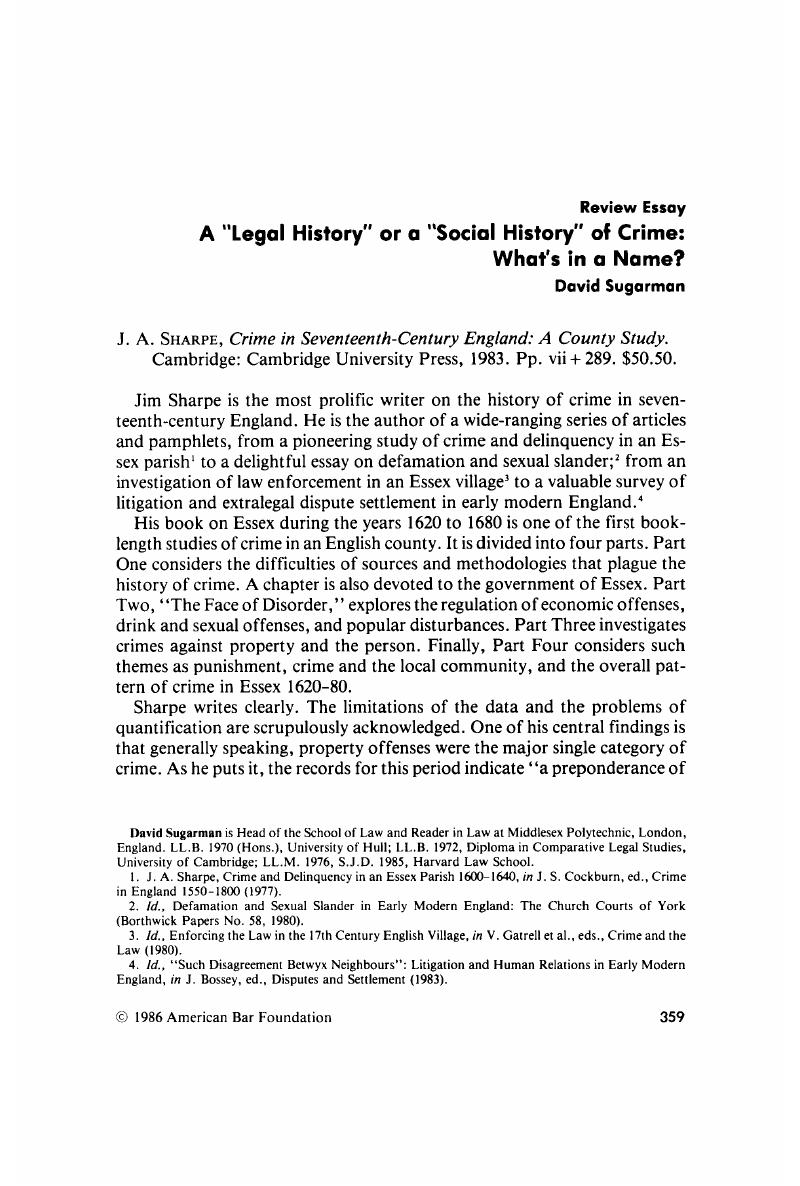No CrossRef data available.
Article contents
A “Legal History” or a “Social History” of Crime: What's in a Name?
Published online by Cambridge University Press: 20 November 2018
Abstract

- Type
- Review Essay
- Information
- Copyright
- Copyright © American Bar Foundation, 1986
References
1 J. A. Sharpe, Crime and Delinquency in an Essex Parish 1600–1640, in J. S. Cockburn, ed., Crime in England 1550–1800 (1977).Google Scholar
2 Id., Defamation and Sexual Slander in Early Modern England: The Church Courts of York (Borthwick Papers No. 58, 1980).Google Scholar
3 Id., Enforcing the Law in the 17th Century English Village, in V. Gatrell et al., eds., Crime and the Law (1980).Google Scholar
4 Id., “Such Disagreement Betwyx Neighbours”: Litigation and Human Relations in Early Modern England, in J. Bossey, ed., Disputes and Settlement (1983).Google Scholar
5 Contrast the picture of Essex with that of Westmorland as portrayed in A. Macfarlane's The Justice and the Mare's Ale: Law and Disorder in 17th Century England (1981).Google Scholar
6 See, e.g., J. Brewer & J. Styles, eds., An Ungovernable People (1980).Google Scholar
7 Cf. W. Hunt, The Puritan Movement: The Coming Revolution in an English County (1983), which also concentrates upon the county of Essex.Google Scholar
8 On the impact of the plague on law, order, and government, see P. Slack's fine study, The Impact of the Plague in Tudor and Stuart England (1985).Google Scholar
9 See also B. Lenman & G. Parker, The State, the Community and the Criminal Law in Early Modern Europe, in Gatrell et al., supra note 3.Google Scholar
10 The classic study is still D. Hay, Property, Authority and the Criminal Law, in D. Hay et al., eds., Albion's Fatal Tree (1975).Google Scholar
11 Hunt, supra note 7.Google Scholar
12 See also A. L. Beier, Masterless Men: The Vagrancy Problem in England 1560–1640 (1985), which testifies to both the seventeenth-century fear of vagrancy and the value of criminal records in reconstructing the social history of the poor and the propertied.Google Scholar
13 J. S. Cockburn, Early Modern Assize Records as Historical Evidence, 5 J. Soc. Archivists 215 (1975).Google Scholar
14 Macfarlane, A., Review Essay on J. S. Cockburn, ed., Calendar of Assize Records: Essex Indictments Elizabeth I, 24 Am. J. Legal Hist. 171 (1980).Google Scholar
15 At 4, discussing Radzinowicz's monumental A History of English Criminal Law and Its Administration Since 1750 (1948–86).Google Scholar
16 Burrow, J., A Liberal Descent × (1981)—though not used in this context. For an attempt to describe some of the intellectual, social, and economic forces that sought to separate law from history and social thought, see D. Sugarman, Legal Theory, the Common Law Mind and the Making of the Textbook Tradition, in W. Twining, ed., Legal Theory and Common Law (1986).Google Scholar
17 Cf. J. S. Cockburn, Seventeenth-Century Clerks of Assizes: Some Anonymous Members of the Legal Profession, 13 Am. J. Legal Hist. 315 (1969). On the importance of the local administration of law and the personnel of jurors in eighteenth-century Essex, see P. King, Decision-Makers and Decision-Making in the English Criminal Law, 1750–1800, 27 Hist. J. 25 (1984). I am grateful to Peter King for allowing me to read his forthcoming review of Sharpe's Crime in 17th Century England.Google Scholar
18 See Sharpe, , supra note 4.Google Scholar
19 Cf. D. Sugarman, Theory and Practice in Law and History, in B. Fryer et al., eds., Law, State and Society (1981); D. Sugarman, Law, Economy and the State in England, 1750–1914: Some Major Issues, in D. Sugarman, Legality, Ideology and the State (1983); and D. Sugarman & G. R. Rubin, Towards a New History of Law and Material Society in England 1750–1914, in G. R. Rubin & D. Sugar-man, eds., Law, Economy and Society, 1750–1914 (1984).Google Scholar
20 J. A. Sharpe, Crime in Early Modern England 1550–1750 (1984).Google Scholar
21 John Beattie's study, Crime and the Courts in England, 1660–1800 (1986), was published in Britain as this review went to press. Other recent major work on the history of crime includes N. Landau, The Justices of the Peace, 1679–1760 (1984), and T. A. Green, Verdict According to Conscience: Perspectives on the English Criminal Trial Jury, 1200–1800 (1985).Google Scholar


